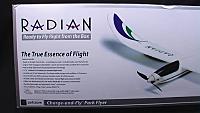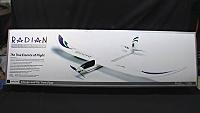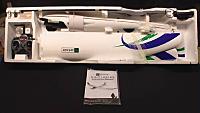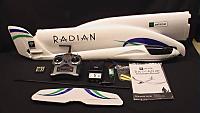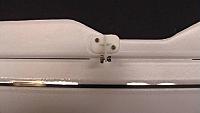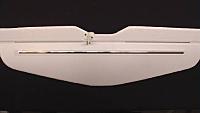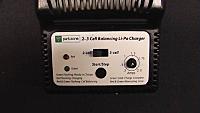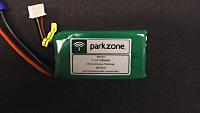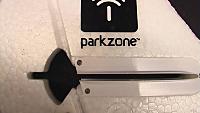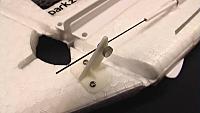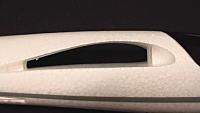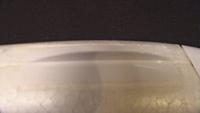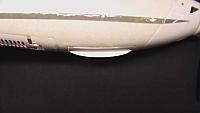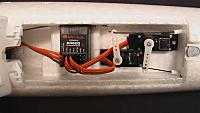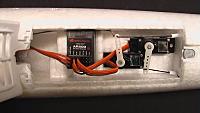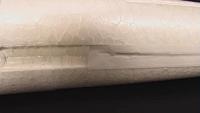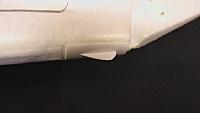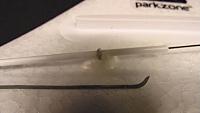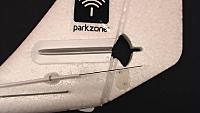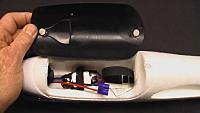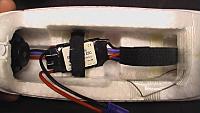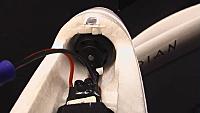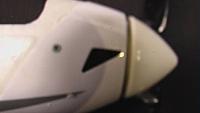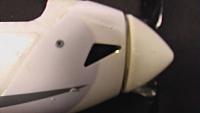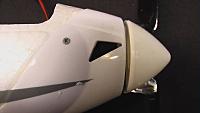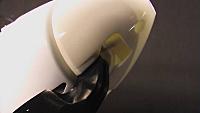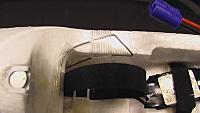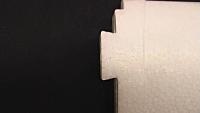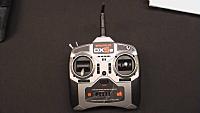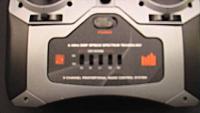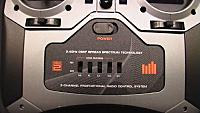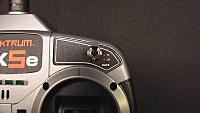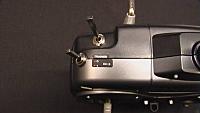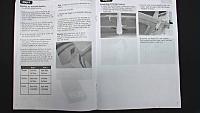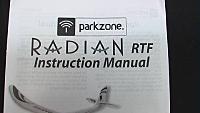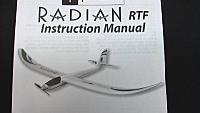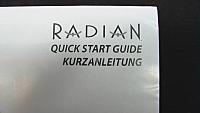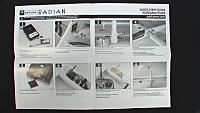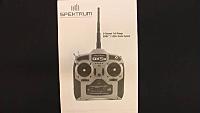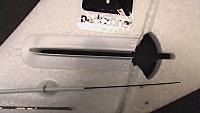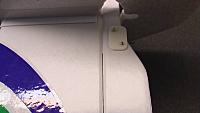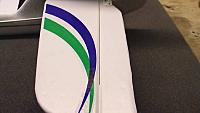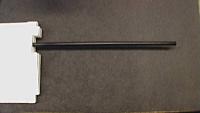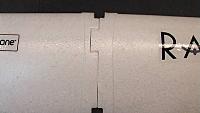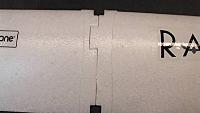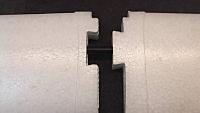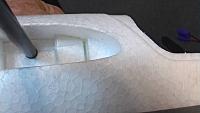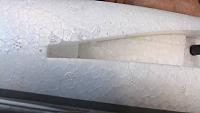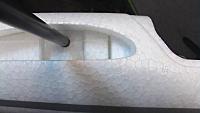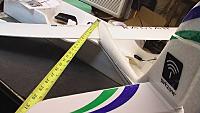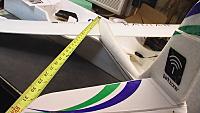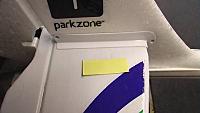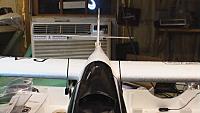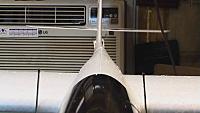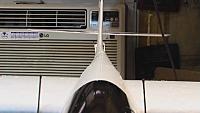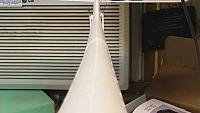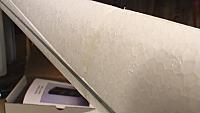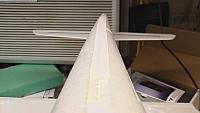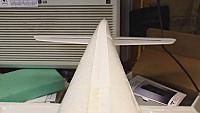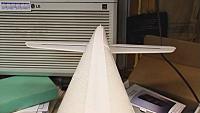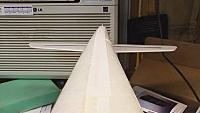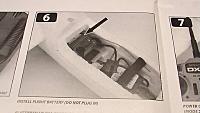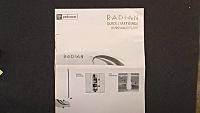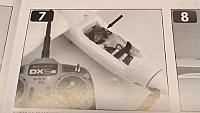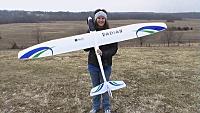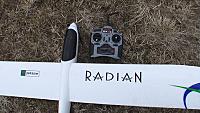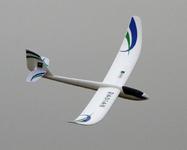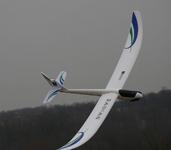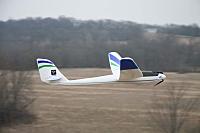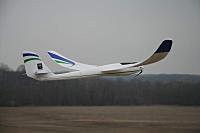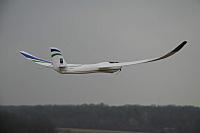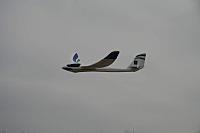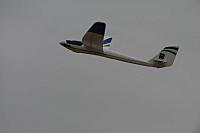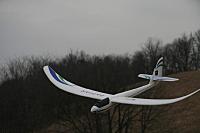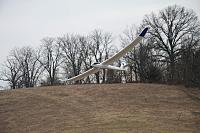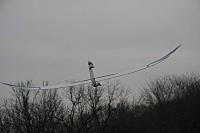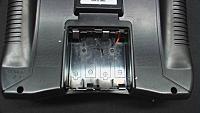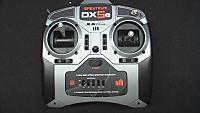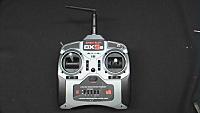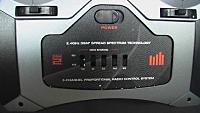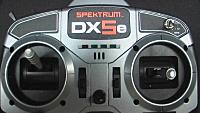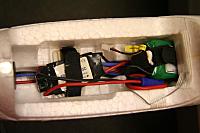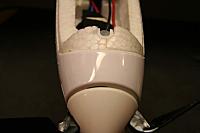|
|
|
|
Thread OP
|
ParkZone's Radian 2.4 GHz RTF Powered Sailplane Review
!Introduction
| spec2 | @IMGA0448.jpg |> <b>Wingspan:</b> |< 78.74" / 2000mm -2M |> <b>Wing Area:</b> |< 632 sq. in. / 39.2 sq. dm. |> <b>Weight:</b> |< 30 oz. / 830g |> <b>Length:</b> |< 44.7" / 1137mm |> <b>Wing Loading:</b> |< 6.608 oz/sq. ft. / 21g/sq. dm. |> <b>Servos:</b> |< SV80 Sub Micros |> <b>Transmitter:</b> |< Spektrum DX5e 2.4 GHz DSM2 |> <b>Receiver:</b> |< Spektrum AR500 Full Range |> <b>Battery:</b> |< 11.1 V LiPo - 30 Minute Flight Times |> <b>Motor:</b> |< PKZ 480-size, 960Kv Brushless Outrunner |> <b>ESC:</b> |< E0flite 30 amp brushless with switching BEC |> <b>Features:</b> |< RTF, Plug-in wings, 2.4 GHz, Charger, Brushless, Z-Foam, folding prop |> <b>Manufacturer:</b> |< <a href=http://parkzone.com/>Parkzone</a> |> <b>Available From:</b> |< Your Local Hobby Shop |> <b>MSRP:</b> |< $249.99 RTF and $159.99 PNP The Radian is exemplary of all things good in powered three-channel gliders and trainers: slow in flight, visible, predictable, stable, hand launch-capable, easy to land and it is mildly aerobatic. Add that itís a true blue RTF that requires about 30 minutes of building and you have a plane that provides a quick path to instant gratification. Parkzone has followed a formula for RC success in this plane that includes good design, quality components and great flight characteristics. That in itself that is enough, but Parkzone has also included the Spektrum DSM2 2.4 GHz DX5e transmitter and an AR500 full-range receiver to make it even better, and it is also available as a PNP. !Kit Contents Mine arrived in a huge box, double packaged, with only a few slight dents in box. Everything inside was secured well. @IMGA0161.jpg: At two meters, this bird is big. @IMGA0159.jpg: The True Essence of Flight @IMGA0165.jpg: I am always amazed at how nicely the packaging is designed. For those of you new to 2.4 GHz this RTF version includes one excellent starter 2.4 GHz transmitter. The DX5E is fully functional with buddy-box compatibility, servo reversing, digital trims, elevon mixing, dual rates (preset), channel five switch, and it all operates on 4.8 volts (four AA cells). It is also upgradable to rechargeable batteries. The airframe and wings are Z-foam. Z-foam is resilient, easily repairable and looks good with its slick finish. The horizontal stabilizer is layered with a finished hard surface for stiffness and durability. The vertical control stabilizer and rudder are Z-foam. @IMGA0168.jpg: A quality RTF *RTF Includes (this is a complete parts list - all components are installed): *Folding Prop - PKZ1017 *Prop Adapter - PKZ1018 *11.1 Volt 130 mAh LiPo Battery - PKZ1033 *2-3 cell DC LiPo Balancing Charger - PKZ1040 *SV80 Sub Micro Servos - PKZ1060 *Decals - PKZ4703 *Canopy - PKZ4713 *Installed Firewall - PKZ4714 *480 Outrunner Brushless - PKZ4716 *Carbon Main Wing Spar - PKZ4720 *Pushrods - PKZ4722 *Tail Set -PKZ4725 *Fuselage - PKZ4767 *DSM2 5 Channel Receiver - SPMAR500 *30 amp brushless ESC - EFLA-1030 *Four AA Alkaline Batteries *Full set of instructions with a quick start guide *Optional Components: *11.1V 1250 mAh LiPo - EFLB12503S *1-5 Cell Charger and Balancer - EFLC505 *Alligator Clips - HBZ6513 *AC to 12V power Supply - THP1205P *Neck Strap - SPMP300 *1500 mAh NiMH Receiver Pack - SPM9525 *Wall Charger 150 mA - SPM9526 *Trainer Cord - SPM6805 !Assembly The Radian is a quick build, so I suggest you get that battery on the charger so it will be ready when you finish! ďAssemblyĒ is a six step process from unpacking to taking to the air. !!Step 1 - The transmitter Get those included batteries installed in your transmitter. The Spektrum 2.4 GHz radios differ from your FM radio in their much more efficient use of power. Those four batteries will give you nearly 24 hours of flight time. After several trips to the flying field you will notice the LED lights showing less than full power. !!Step 2 - The battery and charger The 2-3 cell balancing charger uses the balance tap (Charge Lead) for charging. The charger is capable of charging 0.3 and 2.0 amps. There is a switch to set the cell count and a rotary dial to adjust the amperage. Connect the charger to a 12 volt power source, listen for the beep and look for the green LED to light up. Set the amps and the voltage switch, connect the battery and push the start button. Itís as easy as that! The charge takes about an hour. The green light flashes to indicate the battery is balancing, a beep signals the completion for the charge. @IMGA0173.jpg: An easy to use charger @IMGA0174.jpg: The battery is a 15C with a 20C burst 11.1V. !!Step 3 - The Wings There are no ailerons on the Radian. The wings are two pieces with a large carbon spar. I pushed the spar into one wing, taking care that it was seated. I slipped that wing into the fuselage and then slipped the other wing onto the spar. It takes some force to fully seat both wings. I used the contours of the wing saddle to gauge the mating. Over time there will be some movement. A small piece of tape is all that is needed if you feel like having a second line of defense. @IMGA0195.jpg: Note the interlocking portion of the wing root. @IMGA0423.jpg: Both halves @IMGA0196.jpg: The method works well. @IMGA0421.jpg: Here they are mated as they would be inside the fuselage. @IMGA0178.jpg: And here is the wing saddle. @IMGA0424.jpg: The fuselage has a stop for both wings. This is the forward stop. @IMGA0425.jpg: Here is the aft stop. !!Step 4 - The Tail The vertical stabilizer is complete. It is hinged and the rudder servo is connected. @IMGA0177.jpg: The control horns work with adjustable clevises. @IMGA0418.jpg: The control horn is pre-installed. @IMGA0171.jpg: The hinge line is visible. @IMGA0175.jpg: Linkages are contained and secured to the fuselage. @IMGA0172.jpg: A carbon stiffener is provided under the tail. The horizontal stabilizer slips into the receiver in the fuselage and tapes in place. I squared the tail with the wings and used the metal canopy mount instead of the wing tips. The wings move, so using them to square is not a good idea. I used the provided tape to secure the top and bottom of both sides. @IMGA0417.jpg: This is really the only build on the Radian. @IMGA0428.jpg: Keep going back and forth. @IMGA0429.jpg: The tape secures the horizontal stabilizer to the plastic support. @IMGA0176.jpg: The horizontal support also stiffens the vertical surface. @IMGA0419.jpg: The hinge is molded in and only located in the center and at the tips. !!Step 5 - The Fuselage The radio is located on the underside, and the battery is under the canopy on the topside. It is obvious the Radian 2.4 GHz AR500 electronics were intended for this location from the beginning as evidenced by the molding in the fuselage. @IMGA0181.jpg: The servos and AR500 receiver are well nested. @IMGA0188.jpg: The upper battery and ESC compartment @IMGA0189.jpg: The 480 size brushless motor is tucked up front. @IMGA0192.jpg: Cooling ports are located behind the prop and spinner. @IMGA0194.jpg: Note the AR500 antennae. Tail and forward skids are provided under the fuselage, and seams are sealed with tape. @IMGA0184.jpg: The rear skid @IMGA0180.jpg: The forward skid - Note the electronics bay door. @IMGA0183.jpg: The seam tape !!Completion The preferred CG location is 2.5 inches behind the leading edge of the wings at the wing root. I moved the battery aft as far as I could. @IMGA0443.jpg: The arrow points to the forward edge of the battery. !The DX5e @IMGA0294.jpg: This, included with the RTF Radian, is a perfect combination. *The Radian AR500 comes bound to the DX5e from the factory. If for some reason you have to rebind (for example, setting your fail-safe option): *Insert the bind plug (provided and labeled) into the BATT/BIND port and power the receiver using the 1300 mAh battery power plug on the battery. The LED on the receiver will begin flashing. *Set the transmitter sticks to the correct fail-safe locations (neutral and low throttle), and while holding the trainer switch on the top left of the transmitter, turn on the transmitter. The transmitter LEDs will flash, and then the receiver LED will hold solid. You can release the trainer switch after you see the flashing LEDs. The bind process will continue even though you arenít holding the switch. *Release the trainer switch and remove the bind plug, and the connection will be complete. *AFTER PROGRAMMING, BE SURE TO REBIND THE SYSTEM SO YOUR FAIL-SAFE SETTINGS ARE CORRECT. The DX5e does not have bind memory, so each different plane you fly with that transmitter will require rebinding. A quickstart guide can be found <a href=http://www.horizonhobby.com/ProdInfo/Files/DX5eQuickStartGuide.pdf>here</a>. @IMGA0291.jpg: An excellent introduction to 2.4 GHz !!Fail-safe *Fail-safe features: *Prevents unintentional electric motor response on startup *Eliminates the possibility of overdriving servos on startup *Establishes low-throttle fail-safe if RF signal is lost *The AR500 removes servo output pulses to all channels except the throttle during fail-safe. *The AR500 throttle fail-safe position is stored via the throttle position on the transmitter. *If you turn on the RX first accidentally, fail-safe will prevent the throttle from advancing. !!Range Checking The DX5e makes range checking so simple that it should become a habit whenever you fly. I turned on my transmitter and then the receiver, secured the plane to the ground and walked about 90 feet away from the model. Facing the model, I pulled and held the trainer switch and then toggled the Hi/Lo rate switch four times. The transmitter LEDs flashed and an alarm sounded indicating the range check was programmed. You should have total control of your model, and all control surfaces should move with your control inputs. To return to normal operation, I turned off the transmitter and then turned it back on. When turned off, the fail-safe returns the control surfaces to their fail-safe positions. @IMGA0293.jpg: Lots of functionality @IMGA0290.jpg: 4.8 volt !Step Six - Flying The Radian weighs in at just about two pounds and has an incredible wing loading of 6.6 oz. sq. in. You really have to experience this size of a plane with this low of a wing loading. I waited for the perfect day to fly my Radian for the video. I had flown it several times before, but I wanted some wind to show how it handled. With a steady nine mile an hour wind, I took to the air. The Radian is a soaring sailplane - not a hot-liner, not just a powered glider that lethargically climbs and lets gravity take over - it is a soaring plane of unique character. In the video I was able to fly without power through most of the video. At the end I bumped the throttle twice, but otherwise I flew without any power assist, and it was really something to experience. The wind was meeting the slope I was flying from at a perpendicular angle so I was able to endlessly go back and forth. If I had had a chair, I really think I could have flown for hours on a single pack. Prior to the video flight, I had flown the Radian twice and never charged the battery between flights. In total, I may have throttled one to two minutes in all those flights. Soaring requires wind, lift or both. This time of year, thermal lift is just not there but we have plenty of wind. You will see in the video how well the Radian penetrates and the authority the tail and rudder have. I crabbed, and in spite of the crosswind and force on the tail, it did not weather vane into the wind (listen to the wind howling). I turned into the wind and lifted the windward wing, and I got no tendency to push the turn the Radian outside the control I input. I did need to use the high rate in the wind, which is a feature of the Spektrum DX5e. !!Basics The Radian has so many great features. There is power when you need it; It is quick and will get you vertical in short order. The wing design is stable, but it does so with the winglets and not with over-stabilizing dihedral. Throughout the video you will never once see the Radian buffet. It is as stable into the wind as it is across the wind and downwind. The Spektrum DX5e is light, which is a good thing because in the right conditions, the Radian will follow your inputs for hours. The instruction manual indicates 30-minute flights, but I found that if I could get some wind or lift and I had the makings for a fun day of flying without the transmitter fatigue. One word of caution: be sure to keep the wires away from the outrunner. I pulled the battery coupling aft and placed it near the battery. This pulled the wires aft and away from the motor. @IMG_3705.jpg: You can see how far back the battery is located and the connector tucked up next to the battery pulling the wires aft. !!Taking Off and Landing A light hand launch is all that is necessary. It leaped out of my hands and climbed straight up quickly; a good attribute on days where wind and lift are difficult to find. Fun flying with power and without power is possible. Landings are gentle. The Radian will stall, but itís not something you are likely to see on landings. Stalls were straight ahead. You can see in the video I have a hard time getting it down. Landing was really more of a commitment to ending the flight, and I had to nose it down slightly to grab the ground. !!Aerobatics/Special Flight Performance The Radian is mildly aerobatic. It will do loops all day long both powered and unpowered. It will fly inverted, but I had to enter the inverted flight from the top of a loop. I could not get the Radian to roll over very easily. When it is inverted it looks like a huge bird setting its wings for a landing so it is impressive to say the least. !!Is This For a Beginner? It is for the beginner, but at least get a spotter to help you. The Spektrum DX5e does have a trainer port that connects to another Spektrum master radio or JR radio. It is stable, a slow flyer and the Z-foam construction is likely very durable. Parts are also easily available. @IMG_3707.jpg: The motor housing is strong with a lightweight prop and spinner !!Flight Video/Photo Gallery @IMG_3672C.jpg: The Radian is a 2-meter sailplane that is easy to see in the air. @IMG_3675C.jpg: I found controlling the Radian easy, even in 9 MPH winds. @IMG_3602.jpg: Great lines in the air @IMG_3604.jpg: Even though it has a wide wing span, the wings had little flex. @IMG_3593.jpg: Square in all aspects @IMG_3590.jpg: The folding prop and Eflite ESC with brake worked perfectly. The videos are both bigger than I usually provide. The longer video is worth the download time; it shows the flight stability, and you can hear the wind blowing in the camera microphone. Watch and notice the wing and how it remains under my control and not in the windís control. Note the authority of the rudder to push the Radian where I wanted it to go. In the longer version, am able to soar for almost six minutes, and at times, very close to the ground. I was catching uplifting winds coming perpendicular to the hill. It was a blast! +Radianvideo.wmv:Itís very easy to soar with the Radian (longer version) +Radianvideoshort.wmv:Itís very easy to soar with the Radian (shorter version) !Conclusion Well, you gotta have one of these! You will learn to chase thermals and winds and enjoy every minute of the experience. It was easy to build, easy to fly and made me want to get more air time in even tougher conditions. You will be amazed at the construction and design and how those join with the flight characteristics to make the Radian one really great soaring sailplane. I highly recommend Radian for all types of flying. *Pluses: * Easy to build as an RTF should be *An available PNP version *Power to climb *Long flights *Strong construction *Excellent wing airfoil design *Good decal scheme making it easy to see *Minuses: *The wings join in the wing saddle, but will slide some *The RTF package should include a chair ;) ImagesView all Images in thread
|
|
Last edited by Angela H; Mar 11, 2009 at 05:43 AM.
|
|
|
|
|
|
|
|
|
I loaded up a 1st time flier with this plane and now he's flying solo and looking for his next plane. Nice balance of power and sailplane

|
|
|
|
|
|
|
|
|
You can buy all of the components individually to make one from scratch or replace broken parts. Otherwise it is with or without transmitter, receiver and battery/charger. It is a great flying plane as seen in the video of mine in the Arizona Electric Festival Review here in Liftzone from last month. Mike Heer
PS: Nice Review Dave |
|
|
Last edited by Michael Heer; Mar 11, 2009 at 01:07 PM.
|
|
|
|
|
|
I've been flying for a long time and decided to get one of these for a fun bird. I checked out all the comments on our forum as I always do before buying any plane and was shocked. Normally there are good and bad comments on most planes. All I could find were good comments... no, raves on this plane. So I bought it.
I took it out last week, got it ready to go, gave it a test throw for balance and it just floated. I then thought, go for it and I hit the throttle. I was once again shocked at the climb this guy has got! I read comments that experienced flyers suddenly start looking at there hanger and all the money there and then at the Radian and it's price and wonder. I know exactly what they mean now! Don't get me wrong. I'm not giving up my 3m planes but I am really impressed on what you get for the $ here. I can't say enough good about this and recommend this to anyone that wants a fun flyer! Dave |
|
|
|
|
|
|
|
|
Great review! Maidened my friends last weekend, truly a joy to fly!
One thing though- when you listed the components, I believe you ment 1300 mah, not 130 mah. RTF Includes (this is a complete parts list - all components are installed): Folding Prop - PKZ1017 Prop Adapter - PKZ1018 11.1 Volt 130 mAh LiPo Battery - PKZ1033 2-3 cell DC LiPo Balancing Charger - PKZ1040 SV80 Sub Micro Servos - PKZ1060 Decals - PKZ4703 Canopy - PKZ4713 Installed Firewall - PKZ4714 480 Outrunner Brushless - PKZ4716 Carbon Main Wing Spar - PKZ4720 Pushrods - PKZ4722 Tail Set -PKZ4725 Fuselage - PKZ4767 DSM2 5 Channel Receiver - SPMAR500 30 amp brushless ESC - EFLA-1030 Four AA Alkaline Batteries Full set of instructions with a quick start guide Optional Components: 11.1V 1250 mAh LiPo - EFLB12503S 1-5 Cell Charger and Balancer - EFLC505 Alligator Clips - HBZ6513 AC to 12V power Supply - THP1205P Neck Strap - SPMP300 1500 mAh NiMH Receiver Pack - SPM9525 Wall Charger 150 mA - SPM9526 Trainer Cord - SPM6805 Assembly another plane Im going to have to add to my hangar! |
|
|
|
|
|
|
|
Thread OP
|
Yes definitely a 1300 mAh pack. I agree little in the way of negatives. When I received the kit I noted the tail (at least) mine was joined on one side with glue. I contacted the manufacturer and they indicated this was normal. A slightly out of square tail also existed, but while I saw it I could not convey that through pictures to the manufacturer. Whatever I saw did not influence flight so I moved one. Not sure anyone else sees this, but whatever: the flying is excellent.
Keep in mind the wires from the ESC to the battery and make sure they do not get close to the outrunner or they will get worn through and short out. I folded the connector up next to the battery. Chip I have always thought powered sail planes make great trainers. Glad you have had a good experience. I have also flown mine with my nephew. It was really windy that day and while he could turn, he struggled to keep the nose level into the wind. I think some more practice and he will solo very soon. For me wind is what I like and where planes like the the Radian really soar. Thermals are different so be careful. It can catch one and be gone. |
|
|
|
|
|
I'm loving mine. The thing that sets this one apart is that it truely does fly like a nice unpowered 2M sailplane. It's light and very well mannered and does exactly what you ask of it with no tipstalling no matter how far it's banked. My first trim glide went like this. Toss, ten feet out it looked ok, power on for 5 seconds, off to a nice glide,bump, turn into it, 10 minutes later I had to start spiraling or it'd been my Radian's first and last flight. I might as well have been tossing a Gentle Lady up a high start.
|
|
|
Last edited by wingsnapper; Mar 12, 2009 at 03:50 PM.
|
|
|
|
|
|
I'm sold....
I am already responsible for 4 radians and teaching 4 new pilots!...
both versions were a snap to be flight ready and absolutely zero trim issues out of the box. The climb-out was great, and indicates lift well. A real floater. I normally fly much higher-end stuff and was impressed. While on a job Texas, I bought two so I had something to fly, and taught two to fly it. A third guy bought one for himself. When I left Texas, I sold the one I flew, and told my friend in Tucson that the radian was the one to start with. 20 minutes of buddy-box time and he spec'ed out! He got it so high that I had to take it from him and work it down! He's hooked... The only mods and notes:

|
|
|
Last edited by SUNSQUINT; Mar 12, 2009 at 02:02 PM.
|
|
|
|
|
|
I flew mine here in the desert last week and it does all of that and more. The climb rate is phenomenol and it floats like a feather.
One comment about the review. In the video it looked like you were actually flying off of a slope with the wind coming up it. If that is the case then it looked like you were riding lift from the slope. Just curious. |
|
|
|
|
|
|
|
|
I've been waiting to read a review of this bird before I pulled the trigger....great write up and you've sold me!
I'm sure it will be a bit of a change going from my EDF's back to a slow flyer...especially a glider...but this plane makes it well worth looking forward to those lazy weekend afternoons. |
|
|
|
«
Previous Thread
|
Next Thread
»
| Thread Tools | |
| Similar Threads | |||||
| Category | Thread | Thread Starter | Forum | Replies | Last Post |
| Horizon Hobby's ParkZone Typhoon 3D RTF Review | Stocker | Electric Plane Talk | 9 | Mar 16, 2009 04:00 AM | |
| Horizon's ParkZone Slo-V RTF Review | Fred Sanford | Electric Plane Talk | 3 | Dec 14, 2004 11:34 PM | |
| F/S Big 100 inch Astro FAI 015 Powered Sailplane w/flaps | Jim Blanchfield | Aircraft - Sailplanes (FS/W) | 2 | Jun 25, 2003 04:07 PM | |
| F/S BIG 100 inch Astro FAI 15 Powered Sailplane w/Flaps | Jim Blanchfield | Aircraft - Electric - Airplanes (FS/W) | 9 | Jun 25, 2003 04:01 PM | |
